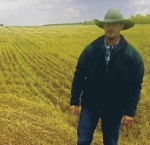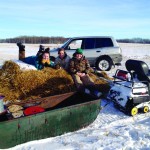
Bunching Saves a Bundle
Management is the key
Bunch grazing crop residues has cut Greg and Paulette Selzler’s winter feed costs by as much as $200 per cow and flip-flopped their strategy for building soil fibre and fertility. Instead of growing forages in rotation to give soil a boost for annual crop production, they now use the annual cropping years and bunch grazing […] Read more

Mixed farming spirit thrives at tee two
Making the most of crop residue
Harvesting grain and putting up feed is one in the same operation for Duane Thompson of Tee Two Land and Cattle near Kelliher, Sask. Crop residues fed in the field have improved soil organic matter and fertility for annual crop production and reduced winter feed costs on the cattle side. Thompson says the symbiotic relationship […] Read moreA BSE update
The spotlight is shifting to atypical BSE cases
Ten years after delivering the shocking news in May, 2003, of the first confirmed case of bovine spongiform encephalopathy (BSE) in a Canadian-born cow, Dr. Stefanie Czub has some very encouraging news. So far, there have been no new cases in Canadian cattle born after the enhanced feed ban came into effect in 2007, indicating […] Read moreHealth is a shared responsibility on this co-operative pasture
The BT usually grazes 800 pairs on 27,000 fragile, sandy acres
The BT Grazing Co-operative is the oldest of its kind in Alberta, dating back to 1952 when local producers formed a co-operative to take up a private grazing lease on 27,000 acres of provincial Crown land in the sandhills, about an hour north of Medicine Hat. Native prairie grasses and shrubs cover the rolling terrain […] Read moreThe Onefour research herd is up for sale
Closing the books on the 86-year-old research substation
Closing the books on the 86-year-old research substation The Onefour Research Ranch herd dispersal sale on November 28 at the Balog Cow Palace in Lethbridge will mark the end of 86 years of range and livestock research at this storied ranch hugging the U.S. border in Alberta’s southeastern corner. It is one of several hallmark […] Read more
Mature cereal forage is better than you might think
You might have your yield, with an acceptable loss in feed value
The recommended stages of maturity for cutting annual cereals for whole-crop forage are based on what’s good for silage. We just always assumed if it works for silage it must work for greenfeed and swath grazing too. Researcher Greg Penner isn’t so sure now, based on some research he’s been involved with at the University […] Read more
UHF tags back in the limelight
They offer greater reading range and a memory
The use of ultra-high-frequency (UHF) technology for animal identification as an alternative or compliment to low-frequency (LF) technology is a fairly recent development around the world. In Canada, the Southern Alberta Institute of Technology (SAIT) Polytechnic’s UHF radio frequency identification (RFID) project funded by the Alberta Meat and Livestock Agency (ALMA) now has 650 UHF […] Read moreSetting the bar high
2012 Agribition was a show to remember at Bar-E-L Angus
Far from the pomp and ceremony of the show ring, Dave and Lynne Longshore grab their touques and head down the lane to start another work day at Bar-E-L Angus southeast of Stettler, Alta. Partway through the daily routine they swing the mix wagon past two small pastures to drop some feed over the fence […] Read moreControlling Canada thistle in pastures
Canada thistles in pastures don’t just look ugly, they cause economic harm with yield losses approaching nearly two to one. That’s two pounds of desirable forage biomass lost for every pound of thistle biomass. The good news is that you will gain the forage back if you remove thistles, says Dr. Edward Bork, professor of […] Read more
The evidence for vaccination at weaning and at the feedlot
It isn’t clearcut, but don’t stop doing it
There are more than 80 vaccines available for cattle in Canada, most are indicated as an “aid in the prevention of disease.” This label category means the product has been proven to effectively prevent the disease by a clinically significant amount, but not 100 per cent. Add to that the variability within the environment and […] Read more



